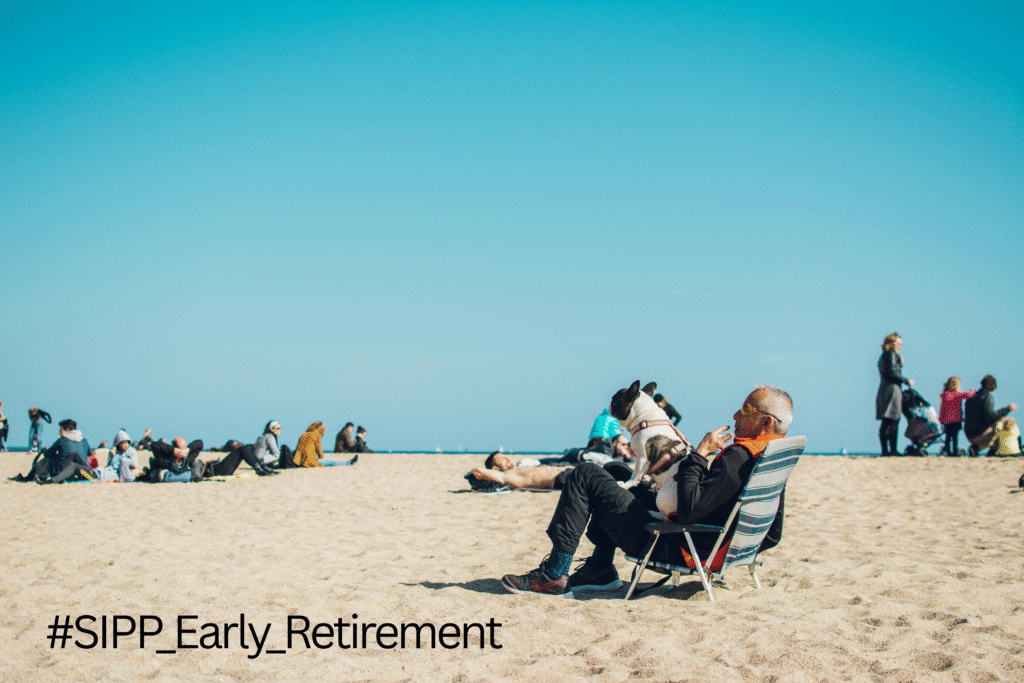Dreaming of early retirement but not sure how to make it happen?
You’re not alone.
Many people want to stop working sooner and enjoy more freedom while they’re still healthy and energetic. The big question is simple: can your pension savings support that lifestyle?
A Self-Invested Personal Pension, or SIPP, can make it possible to retire early, but only if you know how it works and have a clear plan. Early retirement is not just about reaching a certain age. It is about having enough money to live the life you want without constantly worrying about running out.
In this guide, you’ll find clear details on how a SIPP works and practical financial advice to improve your chances of retiring early.

First, What Exactly Is a SIPP?
A Self-Invested Personal Pension is a personal pension that gives you much more control than a standard workplace scheme. With most workplace pensions, your employer chooses the provider, and the investment options are fairly limited. With a SIPP, you’re in charge.
You can choose to invest in:
- Individual company shares
- Funds such as mutual funds, ETFs, or trackers
- Corporate or government bonds
- Commercial property, like offices or shops
- Cash and gilts
This flexibility is the primary reason people consider SIPPs when planning to retire early. You are not tied to a handful of choices from one provider. Instead, you can shape your pension in a way that matches your goals and your risk appetite.
A quick bit of history helps explain why SIPPs exist. They were introduced in 1989 to give individuals more freedom in how they save for retirement. Since then, they have become popular among people who want to consolidate old pensions, maximise tax relief, or simply have more say in their overall finance strategy.
So, who are SIPPs best suited for?
- People who want more control over their investments
- Higher earners looking to make the most of tax relief
- Those with several old pensions want to bring them together
- Anyone aiming for early retirement who values flexibility
When Can You Access Your SIPP?
A Self-Invested Personal Pension (SIPP) is designed to help you save for the future. The trade-off is that you can’t access this money before the specified age.
At the moment, you can start taking money from your SIPP at age 55. From April 2028, the minimum age will move up to 57. So, if you were born after April 1973, you will need to wait until at least 57 before dipping into your pension pot.
Until you reach that age, your money is locked in unless you face a serious health issue or meet very specific conditions. This rule is in place to keep your retirement savings protected and growing for when you truly need them.
Once you reach the minimum age, you will have three main options:
- Take a tax-free lump sum
You can withdraw up to 25% of your pot without paying tax. For many, this is a useful way to clear debts, invest in other assets like stocks and shares, or simply enjoy a financial cushion. - Go into a drawdown
This option lets you keep the rest of your money invested in things like funds, bonds, or stocks while taking a flexible income from it. The first 25% you take is tax-free. After that, any income you draw is taxed like your salary.
For example, if you take a large lump in one go, it could push you into a higher tax bracket that year. It is called a drawdown, where your pot continues to grow, but you also get to enjoy some of it along the way.
- Buy an annuity
An annuity provides a guaranteed income for life, giving you peace of mind that you will never run out of money, no matter how long you live.
Let’s look at a quick example. Imagine you have £400,000 in your SIPP when you turn 55. You could take £100,000 tax-free as a lump sum. The remaining £300,000 stays invested, perhaps in a mix of stocks and funds, to generate a steady income for your retirement years.
This flexibility is what makes SIPPs so powerful. They give you the freedom to shape your retirement plan around your lifestyle and financial goals.
Could You Realistically Retire at 55?
Technically yes, you can retire at 55 with a SIPP. But the real question is whether your savings will stretch far enough. Retiring early means your money may need to last 30 years or more.

The main things to think about are:
- How much have you already saved?
- The lifestyle you want after retirement
- How long does your pension need to cover you?
- Any other sources of income you might have, such as ISAs, rental property, or part-time work
Two different stories
Emma’s early start
Emma began paying £300 a month into her SIPP at age 25. Thanks to regular contributions and steady investment growth of around 6 percent a year, she builds up £400,000 by the time she’s 55. With careful planning, she has realistic options for early retirement, especially when the State Pension kicks in at 67.
John’s late start
John only started saving into a SIPP at 40, putting in £500 a month. By 55, he has just under £150,000. Retiring at 55 would be very difficult unless he cuts back his lifestyle or finds another source of income.
The lesson is clear: early retirement is possible, but it works best if you start early, contribute regularly, and keep your investments working for you.
What About Tax Relief and Does It Really Help?
Yes, and it is one of the biggest perks of saving into a SIPP. The government adds tax relief to your contributions, which gives your pension a healthy boost.
Here is how it works:
- For every £80 you put in, the government adds £20.
- If you pay higher-rate tax, you can claim an extra £20 through your tax return.
- Additional-rate taxpayers can claim back even more.
So in some cases, £100 in your SIPP might have cost you as little as £55.
A quick example
If you put £500 a month into a SIPP for 20 years:
- Without tax relief, you would contribute £120,000.
- With basic tax relief, your contributions become £150,000.
- If you are a higher-rate taxpayer, it could effectively cost you only £90,000 to get £150,000 invested.
That difference is huge, especially when you factor in compound growth. This is why many people see SIPPs as more powerful than ISAs when it comes to long-term retirement planning.
How Much Do You Really Need to Retire Early?
There isn’t one answer, because it depends on the kind of lifestyle you want.
A few scenarios
- A modest lifestyle of around £15,000 per year might need £450,000 to cover 30 years.
- A comfortable lifestyle of £25,000 per year could require about £750,000.
- A luxury lifestyle at £40,000 or more each year could need £1.2 million or higher.
Of course, the State Pension will reduce how much you need. Right now the full State Pension pays about £11,500 a year, although you only get this in full if you have 35 years of National Insurance contributions.
The 4 percent rule
A common guideline is the 4 percent rule. This suggests that if you withdraw 4 percent of your pension each year, your pot should last through retirement. For example, £500,000 could give you about £20,000 a year.
But some experts now recommend 3 to 3.5 percent, since inflation and market changes make the old rule a bit optimistic.
The safest approach is to plan for longer than you expect to live and assume your costs will rise over time.

Can You Keep Working After Drawing from Your SIPP?
Yes you can. Many people like the idea of semi-retirement, where they cut down on work hours but use their SIPP to top up their income.
The catch is the Money Purchase Annual Allowance (MPAA). Once you take income from your SIPP, beyond the 25 percent tax-free lump sum, the amount you can contribute each year drops from £60,000 to £10,000.
This matters if you think you may return to work later or want to keep adding to your pension.
For some people, a phased retirement makes sense. They can keep a small income from part-time work while gradually drawing from their SIPP. This spreads the money out and avoids draining the pot too quickly.
Risks of Retiring Early with a SIPP
Before you picture yourself on a beach at 55, it is important to understand the risks.
- Investment risk: Markets can go down as well as up, and that can affect your income.
- Longevity risk: You might live longer than you expect, which means your money needs to stretch further.
- Inflation risk: Prices rise over time, and your spending power could shrink.
- Policy risk: Governments can and do change pension rules.
- Healthcare costs: Medical and care expenses can eat into retirement savings.
These risks do not mean you cannot retire early, but they do mean you need a plan that is flexible and resilient.
Strategies to Improve Your Chances of Early Retirement
If you’re aiming to retire at 55, planning ahead and making smart financial choices is key. Here are some strategies to help you get there:
Start early
The sooner you begin saving, the more time your money has to grow. Even small amounts invested regularly can build into a large pot over the years, thanks to compound interest. Starting early also means you can contribute less each month compared to someone who starts later but still end up with more savings.
Increase contributions when you can
Whenever you receive a pay rise, bonus, or any extra income, consider putting a portion of it toward your pension or retirement accounts. This way, you’re boosting your retirement fund without cutting back on your usual budget. Small increases over time can make a huge difference in your final savings.
Diversify your investments
Relying on a single type of investment is risky. A well-diversified portfolio spreads your money across different assets such as stocks, bonds, and funds. This balance helps reduce risk and increases the chance of steady growth over the long term, even if one market underperforms.
Combine SIPPs with ISAs
While SIPPs are powerful retirement savings tools, they usually lock your money away until you’re 55. By also investing in ISAs, you gain flexibility, since ISAs allow tax-free access to your money earlier. This combination gives you a safety net if you decide to retire before pension funds are available.
Don’t Withdraw Too Much Too Soon
It can be tempting to dip into your pension as soon as you can, but withdrawing large amounts early can shrink your retirement pot quickly. The longer your money stays invested, the more growth you’ll benefit from. Planning careful withdrawals helps ensure your savings last throughout retirement.
Check Your Plan Regularly
Life changes, and so do your financial needs. Reviewing your retirement plan at least once a year helps you track progress and adjust contributions, investment choices, or goals. Regular check-ins keep you in control and prevent unpleasant surprises later.
Common Questions About Early Retirement and SIPPs
Can I retire at 50 with a SIPP?
Not usually. Your money is locked until 55, rising to 57 in 2028, unless you are seriously ill.
What happens to my SIPP if I die before I retire?
Your SIPP can usually be passed to your beneficiaries. If you die before 75, it is often tax-free.
Can I transfer an old workplace pension into a SIPP?
Yes, many people do this to simplify their retirement savings.
How is a SIPP different from a Lifetime ISA?
A Lifetime ISA can be used at 60 and is capped at smaller contributions. A SIPP offers higher tax relief and broader investment choices.
Do I have to manage the investments myself?
No. You can choose a managed SIPP where professionals handle the investments for you.
Conclusion: Is Early Retirement with a SIPP Really Possible?
The idea of retiring at 55 is attractive, and with the right planning, it can be more than just a dream. A SIPP gives you the control and flexibility to shape your retirement, along with generous tax relief to grow your savings faster.
The responsibility, though, falls on you. Start saving early, contribute consistently, and keep your investments under review. Plan for longer than you expect to live and remember that costs will rise over time.
If early retirement is your goal, the best time to start preparing was years ago. The next best time is today.


